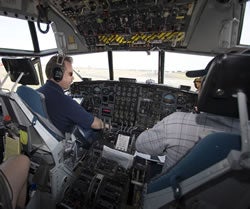NSF/NCAR C-130
Aircraft Overview

The Lockheed C-130 “Hercules” aircraft is a four-engine, medium-size utility aircraft that has proven to be one of the most well-known and versatile aircraft ever built. The NSF/NCAR aircraft is a model EC-130Q, similar to the more common model C-130H model except for electrical and air-conditioning modifications. The aircraft is an all-metal, pressurized, high-wing monoplane powered by four Allison T-56- A-15 turboprop engines. It is equipped with dual-wheel, tricycle landing gear with the main gear wheels arranged in tandem and the nose gear arranged side-by-side. The C-130, maintained and managed by EOL, was placed into service with the NSF in 1992.
The NSF/NCAR C-130 is ideal for studies of the middle and lower troposphere. In a typical research configuration, it carries 13,000 pounds of payload with 8 to 9 hour endurance, and there is considerable flexibility in adjusting payload and range to meet specific mission requirements. It also has the capability to extend a ramp in flight (unpressurized), which allows for the deployment of specialized equipment such as ocean buoys. The C-130 performs a variety of research missions at altitudes below about 26,000 feet. With its excellent low altitude performance and heavy lift capabilities, the C-130 is ideal for studying the planetary boundary layer and lower to mid-tropospheric chemistry missions. In addition to NCAR’s standard thermodynamic, wind and turbulence, microphysics, radiation, and trace gas instruments, the C-130 has a roomy fuselage payload area that can accommodate many rack-mounted instruments with access to several inlets and optical ports. Several wing pods for external instrument stores of varying sizes are also available.
When referencing the NSF/NCAR Hercules C130 Aircraft in publications or proposals, please use the identifier 10.5065/D6WM1BG0 -- for example as a citation:
UCAR/NCAR - Earth Observing Laboratory. (1994). NSF/NCAR Hercules C130 Aircraft. UCAR/NCAR - Earth Observing Laboratory. https://doi.org/10.5065/D6WM1BG0 Retrieved December 20, 2016
Please be careful of line breaks when cutting and pasting the above text, and feel free to reformat to fit your document. Additional citation styles are available at DataCite or CrossCite